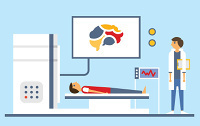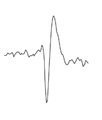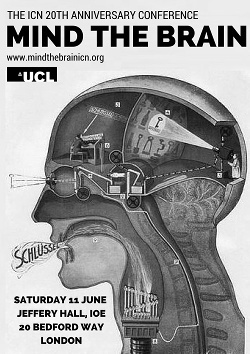Tom Stafford's Blog, page 7
June 23, 2016
Sleight of mind in fMRI
 I’ve written a piece for the BPS Research Digest about a fascinating study that caused people to feel their thoughts were being controlled by outside forces.
I’ve written a piece for the BPS Research Digest about a fascinating study that caused people to feel their thoughts were being controlled by outside forces.
It’s a psychologically intriguing study because it used the psychology lab to conduct the study but it also used the psychology lab as a form of misdirection, so participants wouldn’t realise that the effect of having their ‘thoughts read’ and ‘thoughts inserted into their mind’ was in fact a common trick used in stage mentalism.
The interesting bit came where the researchers recorded whether participants reacted differently when they thought their thoughts were being read (they did) and asked about their experience of it happening (when it never actually did).
They reported a range of anomalous effects when they thought numbers were being “inserted” into their minds: A number “popped in” my head, reported one participant. Others described “a voice … dragging me from the number that already exists in my mind”, feeling “some kind of force”, feeling “drawn” to a number, or the sensation of their brain getting “stuck” on one number. All a striking testament to the power of suggestion.
A really wonderfully conceived study that may provide a useful tool for temporarily inducing the feeling of not controlling your own thoughts – something that occurs in a range of psychological difficulties and disorders.
Link to piece on BPS Research Digest.


June 17, 2016
The mechanics of subtle discrimination: measuring ‘microaggresson’
Many people don’t even realise that they are discriminating based on race or gender. And they won’t believe that their unconscious actions have consequences until they see scientific evidence. Here it is.
The country in which I live has laws forbidding discrimination on the grounds of ethnicity, religion, sexuality or sex. We’ve come a long way since the days when the reverse was true – when homosexuality was illegal, for instance, or when women were barred from voting. But this doesn’t mean that prejudice is over, of course. Nowadays we need to be as concerned about subtler strains of prejudice as the kind of loud-mouthed racism and sexism that makes us ashamed of the past.
Subtle prejudice is the domain of unjustified assumptions, dog-whistles, and plain failure to make the effort to include people who are different from ourselves, or who don’t fit our expectations. One word for the expressions of subtle prejudice is ‘microaggressions’. These are things such as repeating a thoughtless stereotype, or too readily dismissing someone’s viewpoint – actions that may seem unworthy of comment, but can nevertheless marginalise an individual.
The people perpetrating these microaggressions may be completely unaware that they hold a prejudiced view. Psychologists distinguish between our explicit attitudes – which are the beliefs and feelings we’ll admit to – and our implicit attitudes – which are our beliefs and feelings which are revealed by our actions. So, for example, you might say that you are not a sexist, you might even say that you are anti-sexist, but if you interrupt women more than men in meetings you would be displaying a sexist implicit attitude – one which is very different from that non-sexist explicit attitude you profess.
‘Culture of victimhood’
The thing about subtle prejudice is that it is by definition subtle – lots of small differences in how people are treated, small asides, little jibes, ambiguous differences in how we treat one person compared to another. This makes it hard to measure, and hard to address, and – for some people – hard to take seriously.
This is the skeptical line of thought: when people complain about being treated differently in small ways they are being overly sensitive, trying to lay claim to a culture of victimhood. Small differences are just that – small. They don’t have large influences on life outcomes and aren’t where we should focus our attention.
Now you will have your own intuitions about that view, but my interest is in how you could test the idea that a thousand small cuts do add up. A classic experiment on the way race affects our interactions shows not only the myriad ways in which race can affect how we treat people, but shows in a clever way that even the most privileged of us would suffer if we were all subjected to subtle discrimination.
In the early 1970s, a team led by Carl Word at Princeton University recruited white students for an experiment they were told was about assessing the quality of job candidates. Unbeknown to them, the experiment was really about how they treated the supposed job candidates, and whether this was different based on whether they were white or black.
Despite believing their task was to find the best candidate, the white recruits treated candidates differently based on their race – sitting further away from them, and displaying fewer signs of engagement such as making eye-contact or leaning in during conversation. Follow-up work more recently has shown that this is still true, and that these nonverbal signs of friendliness weren’t related to their explicit attitudes, so operate independently from the participants’ avowed beliefs about race and racism.
So far the the Princeton experiment probably doesn’t tell anyone who has been treated differently because of their race anything they didn’t know from painful experience. The black candidates in this experiment were treated less well than the white candidates, not just in the nonverbal signals the interviewers gave off, but they were given 25% less time during the interviews on average as well. This alone would be an injustice, but how big a disadvantage is it to be treated like this?
Word’s second experiment gives us a handle on this. After collecting these measurements of nonverbal behaviour the research team recruited some new volunteers and trained them to react in the manner of the original experimental subjects. That is, they were trained to treat interview candidates as the original participants had treated white candidates: making eye contact, smiling, sitting closer, allowing them to speak for longer. And they were also trained to produce the treatment the black candidates received: less eye contact, fewer smiles and so on. All candidates were to be treated politely and fairly, with only the nonverbal cues varying.
Next, the researchers recruited more white Princeton undergraduates to play the role of job candidates, and they were randomly assigned to be nonverbally treated like the white candidates in the first experiment, or like the black candidates.
The results allow us to see the self-fulfilling prophesy of discrimination. The candidates who received the “black” nonverbal signals delivered a worse interview performance, as rated by independent judges. They made far more speech errors, in the form of hesitations, stutters, mistakes and incomplete sentences, and they chose to sit further away from the interviewer following a mid-interview interruption which caused them to retake their chairs.
It isn’t hard to see that in a winner-takes-all situation like a job interview, such differences could be enough to lose you a job opportunity. What’s remarkable is that the participants’ performance had been harmed by nonverbal differences of the kind that many of us might produce without intending or realising. Furthermore, the effect was seen in students from Princeton University, one of the world’s elite universities. If even a white, privileged elite suffer under this treatment we might expect even larger effects for people who don’t walk into high-pressure situations with those advantages.
Experiments like these don’t offer the whole truth about discrimination. Problems like racism are patterned by so much more than individual attitudes, and often supported by explicit prejudice as well as subtle prejudice. Racism will affect candidates before, during and after job interviews in many more ways than I’ve described. What this work does show is one way in which, even with good intentions, people’s reactions to minority groups can have powerful effects. Small differences can add up.
This is my BBC Future column from last week. The original is here.


Cultures of mental distress
 BBC Radio 4 is currently running a fascinating four-part series called The Borders of Sanity on the interaction between culture and mental illness.
BBC Radio 4 is currently running a fascinating four-part series called The Borders of Sanity on the interaction between culture and mental illness.
It’s been put together by cultural historian Christopher Harding and takes an in-depth look at four particular instances where culture and mental health interact, perhaps in seemingly curious ways if you weren’t familiar with the culture.
It includes episodes on Depression in Japan, Sweden’s Adolescents, Hearing Voices in the UK, and the one to be broadcast next week Healing in Ghana.
The only downside is it’s one of BBC Radio’s occasional programmes that they only make available as streamed audio from their website – presumably to give it an early 2000s internet feel.
However, well-worth a listen. Genuinely fascinating stuff so far.
Link to BBC Radio 4’s The Borders of Sanity.


June 11, 2016
Spike activity 10-06-2016
Quick links from the past week in mind and brain news:

The New York Times has a fascinating piece on the online community of people who believe they are being ‘gang stalked’.
Completely destroy the immune system with chemotherapy and rebuild it with stem cells. A radical experimental treatment that seemed to halt multiple sclerosis with 1 death in 23 out of 24 patients people. One died. Reported by BBC News.
Aeon has a piece on the social function of human sacrifice.
Using image processing to improve reconstruction of movies from brain activity. Remarkable but trippy extraction of video from brain activity from Jack Gallant’s lab. Deep dream esque.
The Washington Post has an interesting piece on the history of seeing racism as a mental illness and its problems.
A New Theory Explains How Consciousness Evolved. The Atlantic has a good piece on Attention Schema Theory.
Mosaic has an excellent balanced piece on the effect of screens, smartphones and devices on young people.
There’s a good obituary for recently deceased legendary psychologist Jerome Bruner in The Washington Post.
Time reports that most violent crimes are wrongly linked to mental illness.
The widely-reported link between older fathers, spontaneous DNA mutations in sperm, and chance of offspring with autism may be due to a confound: men who carry risk factors tend to have children late in life. Good reporting from Spectrum.


June 9, 2016
The cognitive science of how to study
 Researchers from the Bjork Learning and Forgetting Lab at UCLA have created a fantastic video on the cognitive science of how to study.
Researchers from the Bjork Learning and Forgetting Lab at UCLA have created a fantastic video on the cognitive science of how to study.
Despite the fact that we now know loads about what makes for optimal learning, it’s rarely applied by students who are trying to learn a subject or ace a test.
This is a short, clear, helpful video on exactly that.
It looks like the video is set so it can’t be embedded but you can watch it at the link below.
Happy studying.
Link to Pro Tips: How to Study on vimeo


June 7, 2016
Twenty years, one Saturday
If you’re in the UK this Saturday, London’s Institute of Cognitive Neuroscience is celebrating 20 years of peering into the brain with an all-day £5 conference that gathers leading researchers to cover everything from the neuroscience of cannabis to embodied cognition.
 By looking at the talks (warning: pdf format programme), it seems they’re pitched half way between BBC documentary and academic talk, so if you are suitably caffeinated, they should perfectly hit the spot.
By looking at the talks (warning: pdf format programme), it seems they’re pitched half way between BBC documentary and academic talk, so if you are suitably caffeinated, they should perfectly hit the spot.
You can buy tickets online but if you’re not walking through central London trying to pipe energy drinks directly into your bloodstream at 9.30am on Saturday, you can watch it via a livestream which is being hosted on the information superhighway.
Can’t wait.
Link to Mind the Brain conference details.


June 2, 2016
Suzanne Corkin has left the building
 Neuropsychologist Suzanne Corkin, most well known for her work with profoundly amnesic patient HM, has passed away and The New York Times has a fitting obituary and tribute.
Neuropsychologist Suzanne Corkin, most well known for her work with profoundly amnesic patient HM, has passed away and The New York Times has a fitting obituary and tribute.
Although Corkin did a range of work on memory, including testing various medications to treat Alzheimer’s disease, she is in many ways synonymous with amnesic Patient HM, later revealed to be Henry Molaison, who she studied and worked with for most of both of their lives.
Corkin not only took a scientific interest in HM, she also ensured his well-being and appropriate care.
HM had perhaps one of the profoundest amnesias reported in the scientific literature but there is a lovely description in The New York Times obituary that describes how HM formed an emotional memory of Corkin, even though a conscious memory wasn’t present.
But it was her relationship with H.M. that was defining. His profound deficits made their relationship anything but normal — every time she walked in the room, she had to reintroduce herself — but that repetition bred a curious bond over time.
“He thought he knew me from high school,” Dr. Corkin said in an interview with The New York Times in 2008.
Link to Suzanne Corkin obituary in The NYT.


May 29, 2016
Spike activity 28-05-2016
Quick links from the past week in mind and brain news:

One of the earliest hominin constructions ever found hundreds of metres deep into a cave. Fascinating piece in The Atlantic.
Aeon has a fascinating piece on how we come to have knowledge of our own minds.
PET brain metabolism linked to return of consciousness in vegetative state patients. The ‘predict’ headline on the article is a bit misleading in everyday terms – it’s only one study so not good enough evidence to make clinical predictions – but fascinating work covered by Stat.
The Guardian has a piece on psychology’s study pre-registration revolution.
ABC Radio’s The Science Show has an excellent hour-long tribute to Oliver Sacks – in his own words.
How do we choose a romantic partner? Interesting review of studies from The Conversation.
Social Minds has a fascinating post on arguing that it’s about time we identified cognitive phenotypes for the social deficits in autism.


The science of the Psychoactive Drugs Act
The world’s stupidest drugs law, the Psychoactive Drugs Act, has come into effect in the UK last week and it claims to prohibit the creation and supply of all psychoactive substances not already covered by pre-existing drugs laws.
Apart from taking us further down the futile road of prohibition it is premised on something that’s scientifically impossible – testing if a seized drug is psychoactive from looking at its chemical structure.
The government claimed that they had ‘solved’ this problem and they’ve just released their forensic strategy document which, unsurprisingly, doesn’t actually solve it.
What it does do, however, is worthy of attention as it likely raises a whole new set of problems.
We learn from forensic strategy that the test for ‘psychoactivity’ is to submit mystery substances to receptor binding assays – a lab test where the substance is added to cells ‘in a dish’ which have receptors for certain neurotransmitters to see if substances bind to and activate the receptors.
Your brain has many, many different forms of receptors, so the government has defined a list that will supposedly indicate whether a substance is ‘psychoactive’ based on whether a substance binds to and activates one of the following:
CB1 (targeted by cannabis and synthetic cannabinoid type drugs)
GABAA (targeted by benzodiazepine type drugs)
5HT2A (targeted by hallucinogenic type drugs – these can be from a number of different types of drugs)
NMDA (targeted by dissociative/hallucinogenic drugs e.g. ketamine)
µ-opioid (targeted by opioid drugs e.g. heroin) and
monoamine transporters (targeted by stimulant drugs e.g. MDMA, cocaine).
These are indeed receptors that facilitate some of the major recreational drug groups but this is not an adequate definition of ‘psychoactivity’ not least because there are several psychoactive substances that don’t affect these receptors.
Most notable is long-running ‘legal high’ salvia divinorum which is wildly hallucinogenic but has its effect through the non-listed κ-opioid receptor.
So produce a lab-based tweak on the salvinorin A molecule, the ‘active ingredient’ in Salvia, and you have something that won’t be picked up by government tests.
The main problem though, is likely to be that these tests will be over-inclusive. Lots of substances will activate these receptors without having a psychoactive effect.
For example, epinastine is a drug in eye drops that strongly activates the 5HT2A in the lab but which doesn’t have a psychoactive effect because it doesn’t cross the blood-brain barrier.
Acamprosate is a drug used to treat alcoholism, not typically considered to be psychoactive, and yet activates GABAA receptors.
There are many more examples and they’re not hard to track down – mainly because we now have several open databases of drugs and receptor interactions so you can easily find psychoactive drugs that will screen negative or non psychoactive ones that will be falsely detected as mind-altering.
In practice, what this means is that lots of substances – chemicals from the home, the workshop, the lab, and the pharmacy – may screen for ‘psychoactivity’ but not be psychoactive. False positives in other words.
But this approach also shows that the Psychoactive Drugs Act fails at solving the problem it is meant to overcome: underground labs producing new substances faster than they can be added to a list of banned drugs.
The Act just complements a fixed list of banned drugs with a fixed list of banned drug effects – making it just another target for grey market labs to innovate around.
What’s also interesting from the list is what drug effects are not proscribed – and we can probably expect underground innovation in pure D2 dopamine agonist that don’t affect monoamine transporters for uppers, and antihistamines as downers, among others. Although to be honest, most will likely just keep on using the same substances.
But considering that biggest take home from ‘legal highs’ is that they were much worse for your health than ‘illegal highs’ – perhaps the best public health result we can hope for is that the Psychoactive Drugs Act pushes recreational drug users back to using the less harmful classics – speed, MDMA, weed and so on.
And when that’s the best you can hope for, you really know that your drug laws are in a dismal state.


Serendipity in psychological research
 Dorothy Bishop has an excellent post ‘Ten serendipitous findings in psychology’, in which she lists ten celebrated discoveries which occurred by happy accident.
Dorothy Bishop has an excellent post ‘Ten serendipitous findings in psychology’, in which she lists ten celebrated discoveries which occurred by happy accident.
Each discovery is interesting in itself, but Prof Bishop puts the discoveries in the context of the recent discussion about preregistration (declaring in advance what you are looking for and how you’ll look). Does preregistration hinder serendipity? Absolutely not says Bishop, not least because the context of ‘discovery’ is never a one-off experiment.
Note that, in all cases, having made the initial unexpected observation – either from unstructured exploratory research, or in the course of investigating something else – the researchers went on to shore up the findings with further, hypothesis-driven experiments. What they did not do is to report just the initial observation, embellished with statistics, and then move on, as if the presence of a low p-value guaranteed the truth of the result.
(It’s hard not to read into these comments a criticism of some academic journals which seem happy to publish single experiments reporting surprising findings.)
Bishop’s list contains 3 findings from electrophysiology (recording brain cell activity directly with electrodes), which I think is notable. In these cases neural recording acts in the place of a microscope, allowing fairly direct observation of the system the scientist is investigating at a level of detail hitherto unavailable. It isn’t surprising to me that given a new tool of observation, the prepared mind of the scientists will make serendipitous discoveries. The catch is whether, for the rest of psychology, such observational tools exist. Many psychologists use their intuition to decide where to look, and experiments to test whether their intuition is correct. The important serendipitous discoveries from electrophysiology suggest that measures which are new ways of observing, rather than merely tests of ideas, must also be important for psychological discoveries. Do such observational measures exist?


Tom Stafford's Blog
- Tom Stafford's profile
- 13 followers



